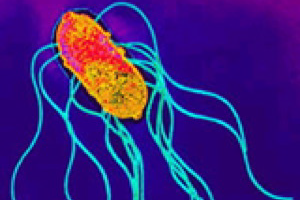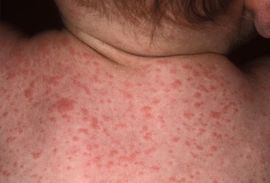Salmonella enterica serovar Paratyphi


Etiology/Bacteriology
Taxonomy
| Domain = Bacteria
| Phylum = Proteobacteria
| Class = Gammaproteobacteria
| Order = Enterobacteriales
| Family = Enterobacteriaceae
| Genus = Salmonella
| species = S. enterica
| subspecies = enterica, serovar paratyphi A, B, and C
Pathogenesis
Transmission
Infectious dose, incubation, and colonization
Epidemiology
Virulence factors
Clinical features
Symptoms

As the name suggests, paratyphoid fever is very similar to typhoid fever and they are often mistaken for one another; however, symptoms of paratyphoid fever have been known to be less severe, as the infection is not nearly as extreme. Symptoms of paratyphoid fever usually occur between 6-30 days after being infected. The most common, and perhaps prominent symptom is severe fatigue accompanied by a fever. The fever typically presents as low-grade and can rise as high as 40°C in the third and fourth days of the illness. Additional symptoms that usually appear are headache, a distinct, red rash all over the trunk, cough, stomach pain, loss of appetite, and constipation or severe diarrhea [4]
Morbidity/Mortality
Once treated, approximately 10% of those with paratyphoid fever will continue to secrete S. paratyphi in their stool for up to three months, which could then be passed on to infect others. Around 2-3% of the recovering patients become permanent carriers for the disease [2]. Paratyphoid fever was once a major cause of mortality throughout the world; however, the infection has begun to be eradicated through various prevention mechanisms. Nevertheless, the disease is still found to be a problem in tropical and underdeveloped countries of the world, typically Africa, Latin America, and South-Eastern Asia. Although the findings are some what inconclusive, it is believed that there is an estimated 5.4 million cases of paratyphoid fever every year [3].
Diagnosis
The diagnosis of paratyphoid fever is usually confirmed by a culture of the blood or bone marrow. As the disease progresses, blood bacterial counts decline, making the blood cultures positive in about only 40-60% of cases. However, the validity of the test can be increased to 80% if multiple sets of blood cultures are taken. The most accurate way to test for paratyphoid fever is by a bone marrow culture because bacterial counts are typically ten times higher in the bone marrow than in a blood culture [2]. Another common way to diagnose the disease is to biopsy the rose-colored rash on the trunk.
Treatment
Prevention
Risk Avoidance
The incidence of enteric fever is most strongly correlated with poor sanitation and lack of clean drinking water. This is because Salmonella paratyphi is transmitted through consumption of contaminated food or water. Therefore, in order to decrease the incidence of this disease, it is important to avoid the consumption of contaminated food or water, provide education about food and water safety, and promote basic sanitation. [1] [2]
Immunization
There are currently no vaccines clinically used to defend against Salmonella paratyphi [2]. Recent studies have indicated that this organism displays evidence of being drug resistant. For example, it was discovered that Salmonella paratyphi has limited sensitivity for ofloxacin, nalidixic acid, and ciprofloxacin. [1]
Because of the evidence for drug resistance, Salmonella paratyphi poses for a potential health risk; therefore, it is thought that developing an effective vaccine should be of importance. There have been studies on the potential use of an oral vaccine that is used to offer protection against typhoid fever in the protection against Salmonella paratyphi as well. The oral live Salmonella typhi Ty21a-vaccine has been shown to offer some protection against Salmonella paratyphi B, slightly less protection against Salmonella paratyphi A, and no protection against Salmonella paratyphi C. [2] These varying levels of protection are due to differences in the shared epitopes of each strain. Despite the research that has been done, there are still no vaccines currently being used in a clinical setting.
Host Immune Response
When the body is infected by Salmonella Paratyphi, a humoral immune response is mounted. The response primarily takes place in the intestinal tract, since the gut is the first line of defense against enteric diseases [3]. Based on research performed with the Ty21a-vaccine, after the host was exposed to the oral vaccine, there was a predominance of IgA antibodies. As part of the immune response, it is believed that after the B cells arrive in the intestinal lining, they undergo isotype switching from IgM to IgA. This specific immunoglobulin isotype is produced to stimulate the destruction of Salmonella bacteria. Other research indicates that a cell-mediated response is also activated upon infection. [2]
References
1 University of Oklahoma Education Abroad.
2
Created by MaKenzi Burke, Madeline Gabe, Regina Swenton, and Jordan Voth, students of Tyrrell Conway at the University of Oklahoma.
This template is just a general guideline of how to design your site. You are not restricted to this format, so feel free to make changes to the headings and subheadings and to add or remove sections as appropriate.
